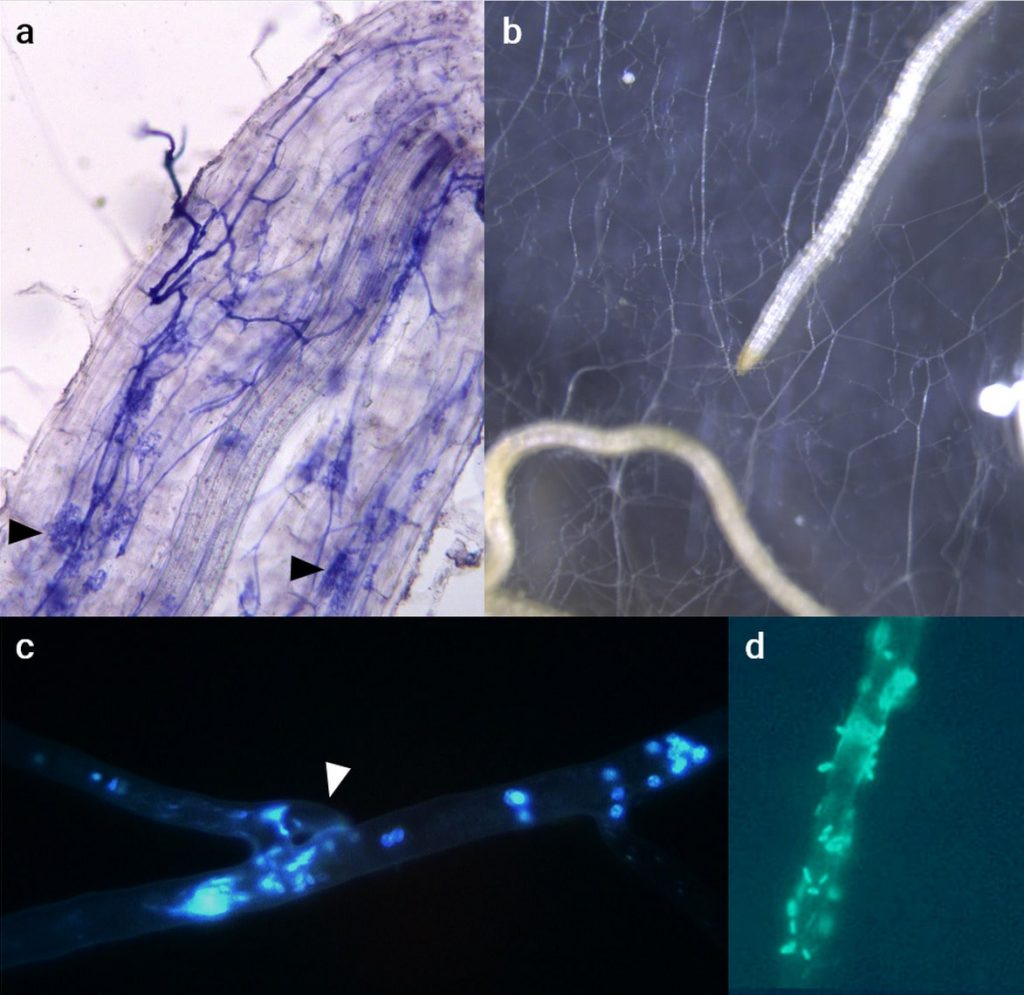
The sharp reduction in energetic and chemical inputs in agriculture needed for sustainable food production can be achieved by using agricultural practices aimed at maintaining biological fertility of soil, i.e. its ability to recover nutrients from organic matter through microbial activities. Active soil fungal and bacterial communities balance the lower input of fertilizers sustaining crop productivity and health, as they are involved in soil nutrient cycling processes – such as degradation, biotransformation and transfer – and in plant protection against biotic and abiotic stresses. Mycorrhizal fungi, soil microorganisms able to establish mutualistic symbioses with plant roots, facilitate crop nutrition and host on their cells (the hyphae) many different beneficial bacteria.
IBBA research is aimed at studying genetic and biological traits of arbuscular mycorrhizal (AM) fungi, which are hosted by the majority of land plants. Due to their obligate biotrophy, AM fungi are not able to complete their life cycle in the absence of the host plant, thus requiring the implementation of peculiar experimental systems. To this aim, a range of simple – microcosm culture involving a single pair of symbionts – to complex systems – controlled conditions mimicking community level or field studies – have been used.
The simplified systems allowed the detection of the early fungal recognition responses, involving chemotropism and differential branching, to root-derived signals released by the host. This step is followed by the development of appressoria, enlarged hyphal tips which are needed for the subsequent AM root colonization. Within host root cells, AM fungal hyphae form tree-like structures (arbuscules, indicated by arrowheads in the colonized root in figure a) through which nutrient exchanges between the fungus and the host take place: plant-derived sugars and lipids are transferred to fungal hyphae, which in turn provide mineral nutrients. Both in AM and in other types of mycorrhizas, e.g. those occurring in roots of forest trees, the main part of the fungal “body” grows outside the host roots, forming a large network of hyphae into the soil (displayed in figure b): the extraradical mycelium. This mycelial network is able to explore a wide soil volume and to enhance the uptake of key mineral nutrients, such as phosphorus, nitrogen, potassium, calcium, copper and zinc.
When more than one host is available, AM fungal hyphae belonging to mycelial networks originating from different root systems may fuse to connect plants – either of the same or of diverse taxa – in a “web”, and to transfer nutrients and information among them (see the exchange of cellular organelles between hyphae in figure c). In case of host death, the mycorrhizal network is able to maintain its viability and the ability to colonize new plants for at least five months. An additional benefit provided by mycorrhizal networks to their partners is the ability to facilitate bacterial translocation through hyphal adhesion (see fluorescently tagged bacterial cells attached to a hypha in figure d), allowing the simultaneous associations of plants with beneficial fungi and bacteria. Unfortunately, it is still unknown which mechanisms are active in mycorrhizal networks to transfer signals among the linked plants and how AM fungal hyphae select the associated bacteria from soil communities.
Growth and health advantages of mycorrhizal plants are mainly due to the AM symbiosis-induced increase in the expression of plant genes involved in nutrient transport, tolerance to biotic and abiotic stresses and synthesis of secondary metabolites. These changes greatly affect plant-derived food quality, and may enhance the production of health-promoting compounds in plant edible parts: zinc, anthocyanins and antioxidant molecules were found to be accumulated in leafy vegetables while calcium, phosphorus, potassium, zinc and lycopene concentrations were high in tomato fruits produced by mycorrhizal plants. However, the responses of plants to mycorrhizal symbiosis are highly variable, depending on the identity of both partners and on the environmental conditions. The analysis of a wide number of wheat genotypes allowed the detection of genetic markers closely associated with plant susceptibility to mycorrhizal colonization, possibly useful for marker-assisted breeding with the aim of obtaining strongly mycotrophic lines. On the fungal side, the diversity and expression of genes involved in phosphorus uptake and transfer are assessed in the AM fungus Rhizoglomus irregulare with the aim of detecting reliable traits for the functional characterization of the different fungal isolates.
It is of note that plant root systems host a complex microbiome, which is shaped by soil characteristics, moisture and plant-microbe interactions. Future studies aimed at detecting variables affecting plant performance and resilience may conveniently integrate data from metagenomic and metatranscriptomic analyses of root microbial communities with those obtained from nutrient fluxes assessments, in different environmental scenarios. The expected findings will provide a comprehensive functional characterization of fungal/bacterial isolates and their consortia, and will improve our knowledge on the functioning of plant/soil microbiomes, on their maintenance and, in case of soil fertility loss, on the microbiome which best fit the different host plants.
Autore: Cristiana Sbrana